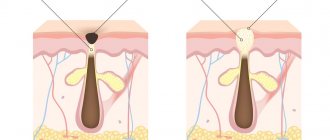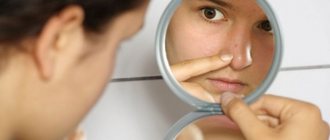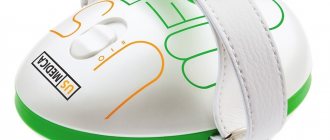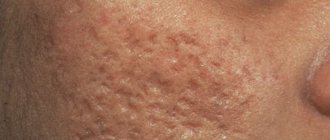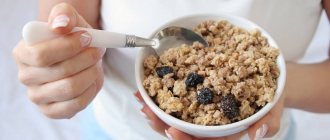06/27/2017 Olga Migunova 3 comments
The face is not only the most exposed part of the body, but also a common location for acne, which can leave post-acne spots - spots, dimples or scars.
The most prone to acne are teenagers who have a lot of complexes about it, because at this age much attention is paid to appearance.
Considering the above, we suggest looking at how to quickly get rid of acne on the face and whether this can be done at home, and, most importantly, without harm to health. We will especially pay attention to how to get rid of acne on the face of a teenager, since this issue is very relevant today. You can also watch a video on this topic.
But first, let’s look at the different types of acne and what causes their appearance.
The main causes of acne
Many people ask the question: “What causes acne on the face?” The photos published in this article clearly show how much even a person’s appearance can change, not to mention what happens under the skin. There are many reasons for acne. The most common are hormonal imbalances or changes caused by age. But there are other reasons.
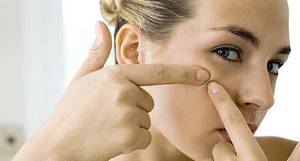
So, let's look at what causes acne on the face:
- excess subcutaneous fat;
- hereditary predisposition;
- poor nutrition;
- stress;
- a lot of dead cells under the skin;
- skin damage;
- inflammation;
- poor facial skin care;
- menstrual cycle;
- lipid metabolism is disturbed;
- the stratum corneum of the skin is enlarged;
- diseases of the stomach and intestines;
- impaired immunity;
- exposure to harmful microorganisms;
- improper use of cosmetics;
- working with toxic substances;
- climate impact;
- excessive cleanliness;
- medicines.
Mechanism of acne development
Acne is caused by blockage of the sebaceous glands. They increase in size due to increased sebum production. Skin pores, which normally should not be visible, expand and become noticeable. At the mouth of the gland, the stratum corneum of the epidermis thickens, as the skin begins to peel off more often. Dead cells completely clog the duct, sebum ceases to be excreted, and the gland stretches. In such conditions, bacteria quickly begin to multiply. They are always present on the surface of the dermis, but do not show pathological activity until favorable conditions are created for this. As a result of these processes, inflammation develops.
Comedon is a term that characterizes an inflamed gland filled with sebum. The inflammatory secretion cannot come out; it remains under the skin and turns into a white acne. Sometimes blackheads are black in color. This happens when a comedone breaks through the surface of the skin, oxidizes, and mixes with melanin, which causes its characteristic color.

Acne can appear on the skin for various reasons. To install them, you need to consult a dermatologist. If acne is a consequence of hormonal disorders in the body, then a visit to an endocrinologist is required. A cosmetologist can help in cases where skin rashes are the result of poor quality or improper care of the dermis.
Foods that cause acne
All the reasons listed above are not a complete list of what causes pimples and acne on the face. Sometimes they appear suddenly. Common products that can help with this include:
- Coffee. It should not be drunk on an empty stomach.
- Animal fats. It is better to replace them with vegetable ones.
- Nuts. You should not eat a lot of walnuts, pistachios and almonds.
- Dairy products. It's better to eat low-fat ones. Eat less cheese and ice cream.
- Sweets (candy, sugar, soda, chocolate, etc.).
- Flour products, especially cakes, chips, cookies.
Folk remedies
It doesn’t matter at what age pimples appear: in adolescence or after 50. If diseases and hormonal disorders are excluded, then you can use folk remedies.
Decoctions based on herbs work well against the inflammatory process on the skin of the face. The most effective are: string, sage, St. John's wort, calendula, chamomile, marigold. You can brew one of them, or mix them in equal quantities. For 250 milliliters of water take 1 tablespoon of the mixture.

The herbs are poured with boiling water and left for 15 minutes under the lid. After this, filter the infusion and wipe your face with it.
An effective way is to prepare frozen lotion. To do this, the cooled infusion is poured into the cells of an ice mold and frozen. This product can be used daily. If you wipe your face with herbal ice cubes in the morning, you can get rid of swelling and bags under the eyes.

Also effective against pimples on the face are:
- infusion of walnut leaves;
- birch buds;
- ripe viburnum berries;
- parsley juice;
- cucumber infusion.
How to choose treatment?
For effective treatment it is necessary to assess the severity of the disease. You can photograph all areas of the skin where pimples, blackheads and blackheads are visible. They determine the degree of the disease. Black dots need to be counted and compared with the scale:
- mild – less than 10 (grade I);
- average – 10-25 (II degree);
- heavy – 26-50 (III degree);
- very severe - over 50 (IV degree).
Already formed inflammations (pimples and blackheads) are also calculated in order of increasing degree:
- 1st degree – less than 10;
- 2 tbsp. – 10-20;
- 3 tbsp. – 21-30;
- 4 tbsp. – over 30.
Classification of acne
Depending on the severity of the disease, there are several degrees of acne:
- Mild severity.
There is no inflammation, but it is noticeable that there are comedones, pustules and papules on the dermis. There are few of them, the total number of rashes does not exceed 10 pieces. Therapy is not difficult.
- Moderate degree.
The number of closed and open comedones is 10-25, and there are also a lot of pimples. Therapy in this case will continue for at least 2 months. The prognosis for complete restoration of the dermis is favorable.
- Severe acne.
There are multiple rashes on the skin, their number can be 30-50 pieces. To cope with acne, complex therapy is required.
- Extreme severity.
The patient's skin is covered with papules, pustules, nodules, cysts, and comedones. Therapy is complex and lengthy; you will not be able to cope with the disorder on your own.
If a person has multiple rashes on their skin, they should not be ignored. Self-medication can lead to worsening of the disease.
Medicines purchased at the pharmacy will not cope with the problem unless prescribed by a doctor. It is very difficult to independently choose the optimal remedy for treating acne.
Acne on the face
What can cause acne on the face? On the forehead, such inflammations most often form due to the large production of sebum. This area of the face contains many sebaceous and sweat glands. Acne and pimples can appear due to diseases of the gallbladder, pancreas, intestines and stomach.
Inflammatory formations above the eyebrows indicate intestinal irritation. Pimples located closer to the hair indicate a malfunction of the gallbladder. The appearance of acne directly on the forehead means possible intoxication of the body as a whole. Acne on the chin indicates a disorder of the digestive or endocrine system.

Pimples that appear on the nose occur due to hormonal imbalance. This is usually the teenage period. If this phenomenon is observed in an adult, the immune system, digestive or endocrine system may be impaired. pimples on the bridge of the nose are a consequence of liver overload and poor blood purification. Pimples appearing on the lips indicate a violation of the digestive system, and on the cheeks - an overload of the lungs.
Skin problems in adolescence
Acne on the face of a teenager most often appears as a result of puberty, since hormones are responsible for the functioning of the sebaceous glands. During this period, a large amount of secretion is produced. And this is a very favorable environment for the growth of bacteria. As a result of an increase in their numbers, inflammation manifests itself in the form of pimples and blackheads.
It is very difficult to treat them during this period, since the reason lies within the body itself. Please note that everyone's skin is different. This means that treatment is selected strictly individually. But there are some general tips:
- daily facial skin care;
- regular contrast washes twice a day (with hot water and then cold);
- use of facial scrubs;
- use of steam baths.

One of the best proven acne treatments is salicylic acid. You can use tar soap and mash. It is prepared in pharmacies according to a doctor's prescription. Apply in the evening with a cotton swab to the face. For external use, brewer's yeast is also good for getting rid of acne. During treatment, you must follow a diet: avoid carbonated drinks, spicy and fatty foods.
Acne in adults
Why do you get acne on your face at 30? Not only teenagers suffer from this problem, but adults can also experience inflammation of the subcutaneous tissues. There are several main reasons why adults also develop acne:
- Hormonal imbalance. In women, this often happens during menstruation or pregnancy.
- Diseases of the gastrointestinal tract.
- Hyperkeratosis (keratinization of the skin). Small “scales” appear. The sebaceous glands work very actively; waste and bacteria accumulate in their mouths. This is where acne and pimples form. This is a very serious and dangerous skin disease that is very life-threatening.
- Demodex mite. One of the most common reasons. Every person has this mite, but it is usually activated when the immune system is weakened. What causes pimples with pus on the face? This is just typical for demodex. Along with inflammation, general redness of the skin is observed. The disease is treated by a dermatologist. At home, you need to change your bed linen more often.
- Stress.
- Poor hygiene.
- Cosmetical tools.
- Squeezing pimples. After removing one, a dozen new ones may appear.
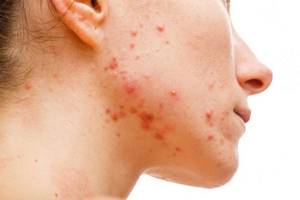
For treatment, it is necessary to correctly determine the cause of acne. But in any case, it is necessary to spend less time in the sun, maintain hygiene and diet, and also take vitamins.
Myths and misconceptions
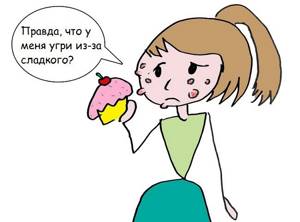
Improper hygiene
It is a myth that a woman gets acne because she doesn't wash herself enough. Cleansing your skin too often and thoroughly can even worsen your skin condition. And clearing oil from the surface of the skin does not help prevent or treat acne because it forms under the skin. The best way to clean your face is to wash it gently twice a day with a mild soap or cleanser. Makeup should also be removed carefully using mild products.
Impact of stress
Stress does not cause acne. But, a rash can be a side effect of certain medications used to treat stress or depression. And in some cases, the social and emotional impact of acne is stressful. You should consult your doctor if problems arise.
Eating chocolate or fatty foods
While many women believe that eating chocolate or fatty foods causes acne, experts have found no link between diet and acne. Foods have little effect on acne for most people, but eating a nutritious diet is important for good health.
How to destroy acne?
Acne needs to be treated only comprehensively. This includes:
- constant facial cleansing;
- restoration of hormonal levels;
- restorative procedures for the skin;
- fight against pathologies and diseases that cause acne;
- face massage;
- masks;
- medicines;
- hardware therapy methods.

What causes acne on the face? They often occur due to poor nutrition. Therefore, it is even more important to follow a diet during treatment. Especially if you are getting rid of acne. It is necessary to exclude protein-enriched, fatty, spicy and salty foods. As well as chips, carbonated and alcoholic drinks, flavored teas, and sweets. You should give preference to fish, cereals, poultry, vegetables and fruits.
Diet
Proper nutrition can reduce acne. You should avoid foods high in saturated fat. Polyunsaturated fats, on the contrary, are healthy. They can be found in fish, nuts, and algae. Such nutrition has a beneficial effect on a woman’s hormonal levels.
Testosterone levels also decrease when you eat foods rich in fiber.
fresh fruits and vegetables in the menu . Meat, coffee, alcoholic drinks and sweets should be avoided.
Medicines to treat acne
What causes acne on the face? Whatever the cause of their occurrence, this is subcutaneous inflammation. Since ancient times, acne has been treated with extracts of witch hazel and chamomile. Triclosan, salicylic acid, zinc oxide and vitamins A, B, C help well. When using these drugs, the layer of sebum decreases, as does the process of inflammation in the follicle and skin. All of these drugs have an antibacterial effect. Pharmaceutical products for acne are divided into two groups: for external and internal use.

For external use:
- Retinoids that target the cause of acne. Suppresses the growth of skin cells, prevents and reduces clogging of pores.
- Antibacterial agents act specifically on bacteria. These drugs include antiseptics and antibiotics.
- Azelaic acid agents inhibit cell division. And this ensures the patency of the excretory skin ducts. These drugs have antibacterial properties. Azelaic acid is found in Aknestop cream and Skinoren gel.
How to deal with acne?
After the appearance of rashes on the skin, the question arises: “What causes acne on the face and how to deal with it?” You can try cosmetics, for example:
- Antibacterial soap. But you cannot use it constantly, but only from time to time.
- Cleansing gels regulate the formation of sebum.
- Anti-aging emulsions-creams prevent micro-inflammations.
- Normalizing gels. Antibacterial agents moisturize the skin and remove excess oil.
- Masking pencils. They have an antibacterial effect and dry out acne. Apply at the first stage of inflammation.
- Moisturizing emulsions prevent acne and moisturize the skin.
Device therapy uses several technologies. For example, a complex pulse consisting of a radio frequency range and a light spectrum. When it hits an inflamed area, the impulse affects the cause of acne. There are other technologies.
What causes acne on the face? You need to pay closer attention to your skin. Perhaps the pores are clogged, there are a lot of dead cells, etc. This can be corrected with chemical peeling, which removes a large layer of the epidermis. This uses glycolic and salicylic acid. To combat acne, superficial peeling is also performed. Laser therapy is sometimes used.

